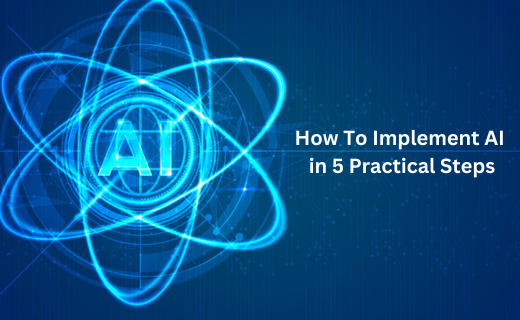-

How To Implement AI in 5 Practical Steps
Moving from a desire to use AI to a tactical approach does not require superpowers, but it can often feel that way. Many data and analytics leaders, unsure of where to begin with AI, become distracted with choosing AI tools and techniques before they understand what they are trying to achieve.
In the 2023 Gartner CIO and Technology Executive Survey, 32% of respondents said their organizations had deployed AI and machine learning (ML), and an additional 17% indicated they would follow suit within 12 months. As organizations increasingly deploy AI, they will look to data and analytics (D&A) leaders to formulate a strategy for the data side of AI.
This five-step formula offers a tactical approach for D&A leaders to get started with AI, focusing on quick time-to-value.
Step 1. Identify Meaningful, Measurable, and Quick-Win Use Cases
Most successful AI and ML initiatives start with the answer, rather than the question. Every project that uses AI should have a clear business impact and measurable outcome. These expectations may change or evolve as the project progresses, but it’s important to firmly establish them at the outset.
Start by examining and selecting AI use cases. Pick a critical problem for the organization, one that traditional techniques have not successfully tackled. Measure business value in addition to feasibility to determine the best opportunities for success. Be sure to also consider time as a key success factor. Scope the problem to a nine-week timeline, which has shown merit in many minimal viable products (MVPs).
D&A leaders must be able to clearly articulate the value proposition of the selected AI use case. Establish metrics that identify how the use case will affect business and financial performance. Look beyond accounting metrics, considering how the MVP could impact business value, information value, or stakeholder value.
Step 2. Assemble the AI Project Team
Three personas provide an ideal balance for AI teams:
- an AI specialist, with expertise in multiple AI techniques such as ML, rule-based systems, or natural language processing (NLP);
- an IT professional who understands the current state of IT capabilities; and
- a subject-matter expert who understands business requirements and metrics.
- A host of skilled professionals will be needed across each persona.
Despite common perceptions, AI skills are not necessarily scarce, expensive, or mysterious. For example, curious database administrators or mathematically inclined data engineers can become great data scientists. When assembling an AI project team, look for those with a combination of sound ML knowledge, a strong understanding of statistics principles, a curiosity for data exploration, and excellent collaboration skills. Motivated, open-minded, competent, and focused champions, often coming from within the organization’s ranks, make a great recipe for successful AI MVPs.
Step 3. Gather the Necessary Data
Another myth plaguing AI exploration is that massive amounts of data are needed to build AI models. Many successful use cases can be achieved using a reasonable amount of data, provided the dataset is relevant and of sufficient quality. The lack of volume can always be compensated for through a reduction in project scope, but a lack of data quality invariably leads to MVP failure.
“A reasonable amount of data” could mean different things depending on the AI techniques that are selected. For example, ML techniques will require significantly more data than logic-based or optimization techniques. Regardless, data quality and relevance for the selected use case should preside over volume.
Step 4. Select AI Techniques That Are Linked To Use Cases, Skills, and Data
Many AI techniques are suited to specific problems, data, and talents. For example, probabilistic reasoning techniques, like ML, work well for uncovering hidden patterns in a large amount of data, like fraud patterns or churn issues. But this requires very high-quality data and analysts who are conversant in analytical mechanisms and algorithms.
On the other hand, consider a use case such as employing AI to manage gate and crew assignments at an international airport during a snowstorm. This situation would be best for optimization techniques, which require talents in operations research and the ability to appropriately gather data. When selecting an AI technique, consider the best fit given the use case, skills, and data available.
In this step, a successful MVP does not exclusively focus on AI techniques. The technology fabric into which the techniques will be woven is equally as important. Discuss other technology considerations at this stage, such as the IT infrastructure resources available, existing process automation, and the user interfaces available to interact with models.
Step 5. Structure AI Expertise
Executing a few MVPs on various business problems across the enterprise should allow organizations to identify gaps in skills, data, and technology, as well as gaps in culture, readiness, and AI education. Once the organization has gone through numerous experiments with AI, consider structuring the accumulated AI know-how into an “AI lab,” “AI competency center,” or “AI center of excellence.” This can help AI experts nurture ties to the business, stay abreast of the organization’s technical capabilities and investments, and remain in sync with the overall AI strategy. AI experts can perform “tours” within lines of business, working closely with subject-matter experts and IT professionals on various projects, for months at a time.
After working through these steps, the organization should consider a larger and more ambitious vision. This formula will help organizations get started with AI, helping to establish the technological and cultural strengths and weaknesses, as well as the desired business outcomes that will inform the longer-term strategy. A formal AI strategy should come after a few learning experiences and be converted into an “AI first” strategy.
Follow us on LinkedInAbout the Author

Kamal Rastogi is a serial IT entrepreneur with 25 yrs plus experience. Currently his focus area is Data Science business, ERP Consulting, IT Staffing and Experttal.com (Fastest growing US based platform to hire verified / Risk Compliant Expert IT resources from talent rich countries like India, Romania, Philippines etc...directly). His firms service clients like KPMG, Deloitte, EnY, Samsung, Wipro, NCR Corporation etc in India and USA.